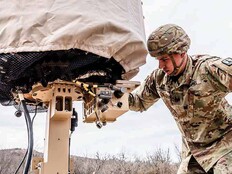As artificial intelligence pervades every facet of society, federal agencies now consider the many ways they can accelerate the use of AI-enabled tools (and whether they’re the right tool for the task). At the Department of Agriculture, the executive leading the charge on that front is Chief Data and AI Officer Christopher Alvares, who recently shared the department’s vision for AI adoption and examples of how USDA teams already leverage the technology. His message to citizens wondering what AI might mean for America’s food, agriculture and natural resources? Challenges and opportunities abound, and USDA is ready for both.
FEDTECH: You were named CAIO in November 2023, shortly after the White House issued its executive order on the use of AI in federal government. Can you share your immediate AI goals for USDA?
ALVARES: My mission is to ensure that USDA responsibly adopts AI to the greatest benefit possible. Although we’ve been developing and using AI models for many years, new AI capabilities have emerged through these foundational models that could help us do even more. We need to have systems and a workforce that are ready for those opportunities, and I see my role as an enabler of that.
Click the banner below to learn more about continuous app modernization.
FEDTECH: What will it take for those efforts to be successful?
ALVARES: Collaboration, education and transparency will be central to our success. I’m working closely with our CIO and others to bring various perspectives on data, technology and security to the conversation, and I’m also working with USDA’s chief human capital officer and our Digital Service office on developing the workforce and hiring AI talent.
I’ve found a great willingness among other federal agencies to share what their AI journeys have been like. When it comes to awareness and education, I recognize that most of USDA has not been immersed in this world of AI as much as I have, and that many in our community have fundamental questions about how they might be impacted by it. We’re working to provide educational resources on AI and ethics to help our workforce develop a level of understanding and comfort so that it’s not a shock as these solutions become a larger, more integrated part of our toolset. We also need to be transparent about where and how we’re adopting AI. The USDA AI Inventory — an inventory of agency use cases — is helpful, but we also need to develop best practices for disclosing when AI is used.
FEDTECH: Are there other challenges or risks you’ll need to address?
ALVARES: AI models don’t always perform the way we expect them to. We’ll need to find ways to evaluate AI and reduce bias and other risks as much as possible so that recipients of USDA programs are not impacted adversely. Ethical issues are incredibly important to consider as well. USDA needs to maintain the public’s trust in its programs and services, and we need to be careful that we don’t allow AI to undermine that trust.
FEDTECH: Can you share how USDA uses AI today? What’s the IT infrastructure required to support those uses behind the scenes?
ALVARES: We’re using AI to strengthen crop estimates, process geospatial data and model potential disease outbreaks, to name just a few. Members of our research community also use AI in a lot of their projects. Our focus has been on developing predictive or classification models, but there are also examples of text mining in our inventory. With generative AI tools, we’re seeing a lot of interest in applying those models to make our business functions more consistent and efficient, and improve how we modernize legacy IT systems.
Some AI models can be developed on laptops, while others use our cloud-based infrastructure and a variety of statistical software packages. We’re also pursuing innovation incubators that will allow anyone at USDA to test and evaluate AI technologies in an environment that is separated or sandboxed off from the rest of our data and systems.
DISCOVER: Government should brace for AI disruption.
FEDTECH: Has the federal zero-trust architecture strategy provided a solid foundation for protection within AI projects? What are your main security concerns for AI, and how has USDA addressed them?
ALVARES: Zero trust is very important. Generative AI has the capability to look across a lot of USDA data, but it could also present data to users who shouldn’t have access to that information. We need to know who is asking and what they’re allowed to have access to, and the models should be constrained to respond based on those permissions. I’d like to see more AI offerings complete the FedRAMP authorization process. And synthetic data capabilities are going to be important, so we can test while protecting private or business-sensitive information.
With generative AI in particular, I’m very sensitive to the risks of data poisoning, model poisoning, hallucinations, data leakage and prompt injections, and we continue to discuss the steps we can take to control for those risks.
LEARN MORE: AI data poisoning is an evolving threat.
FEDTECH: Based on your vision for the agency, how will leveraging AI ultimately benefit citizens?
ALVARES: I think citizens’ experiences with government services need to be improved. Websites can be difficult to navigate; search functions don’t always work well, and chatbots can be limited in their ability to respond. I think AI can improve those interactions. I also see, firsthand, the workloads that our federal workforce must manage. If we can make it easier for USDA staff to do their work, the results would mean faster response times and other benefits for citizens.












